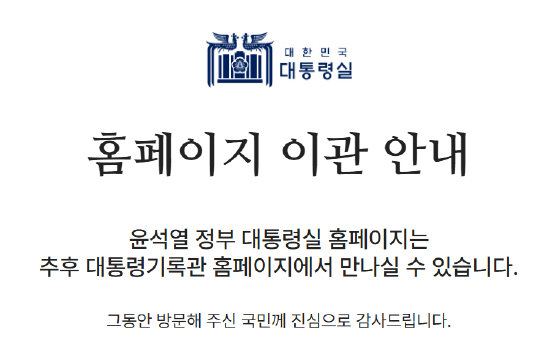Proposal for the Renovation of the Presidential Office Website! Strengthening Communication with the Public and Realizing Democracy at the Core
Introduction: A website is a window that reflects the spirit of the times.
The current homepage of President Lee Jae-myung's office has not yet officially launched. However, the homepage serves as an important symbol that goes beyond merely being a tool for conveying information it visualizes the government's philosophy and its attitude toward democracy. The structure of the presidential office's homepage reveals how the government perceives its citizens and what model of democracy it aspires to. By comparing the homepages of the past two administrations, we will examine what kind of democracy the Lee Jae-myung government should design in the digital space moving forward.
Moon Jae-in Administration: A Laboratory of Participatory Democracy
The website of the Moon Jae-in administration (2017–2022) served as a platform for experiments in digital democracy. In particular, the following features received attention: - National petition board: A system where the government must respond officially if more than 200,000 people agree, allowing citizens to set the agenda directly and structuring a response from the government. - Communication board and comment function: By providing a space to directly collect opinions from citizens and give feedback, it promoted real-time reactions to government policies. - Enhanced accessibility to information: Ensured equal access to information, including various statistics, videos, audio content for visually impaired individuals, and multilingual pages. - Systematic disclosure of policy documents and archives: Made public records and policy briefings accessible to anyone, thereby increasing the transparency of the executive branch. Core evaluation: It received positive feedback for treating citizens as co-subjects of policies, going beyond mere "information delivery." This was an example that met the historical demand for the realization of democracy in the digital space.
Yoon Suk-yeol's government: Reduced to a space of unilateral notification
The homepage of the Yoon Suk-yeol administration (2022–2025) has undergone structural reduction in the digital space following the relocation of the physical space from the Blue House to Yongsan. The main features are as follows: - Abolishment of National Petitions: The representative symbol of direct participation has disappeared. As a result, citizens no longer have a means to directly convey policy requests to the President. - Focus on Image Rather Than Policy: Content centered on the President's statements, messages, and photos gives the impression of prioritizing 'political branding' over citizen participation. - Disruption of Records and Communication: The continuity of records from the Moon Jae-in administration has been severed, and there are virtually no channels for collecting citizens' suggestions or opinions. - Linear UI/UX: A structure that does not consider user experience deepens the digital divide and diminishes the efficiency of information access. Core Assessment: The Yoon Suk-yeol administration's homepage can be summarized as information delivery without participation, policy promotion without records, and a political image without communication. This represents a regression in administration methods in the digital age and indicates a weakening of democratic accountability.
The Direction of the Lee Jae-myung Government: Redesigning Democracy in Digital Space
President Lee Jae-myung has declared that the core philosophy of his administration is focused on people's livelihoods and communication. To realize this, the presidential office's website must become a space of innovation once again. I propose the following directions: 1. Platformization of public participation: The petition system should be redesigned to expand beyond a simple petition function into a 'citizen suggestion platform' based on deliberative democracy. The government's stance on suggestions and follow-up measures should be trackable. 2. Making information disclosure a part of daily life: There should be a policy implementation status dashboard so that citizens can check the progress of policies at any time. 3. User-centered accessibility design: The site should be optimized for mobile and offer various formats. 4. A repository for the records of democracy: It should be linked with records from previous administrations to help citizens understand the historical flow.
Conclusion: Democracy in the Digital Age Begins at the Presidential Office Website
The Yoon Suk-yeol government's website symbolizes a reduction in communication, asymmetric information, and the disappearance of participation. This inevitably leads to a decline in trust in the government. In contrast, the Moon Jae-in administration made attempts to implement democracy in the digital space, and that experience becomes a valuable asset for today's administrative design. Now, the Lee Jae-myung government must redefine the presidential office website as a 'digital governance platform' that creates policies with the people and operates the nation, rather than merely a channel for conveying administrative information. This is not merely a technical issue, but a matter of respecting the citizens and trusting in democracy.

Post a Comment